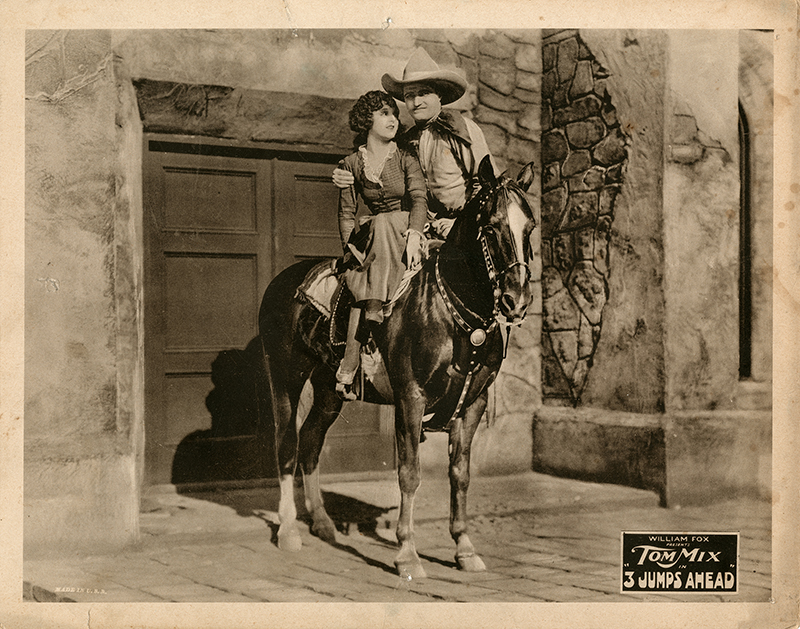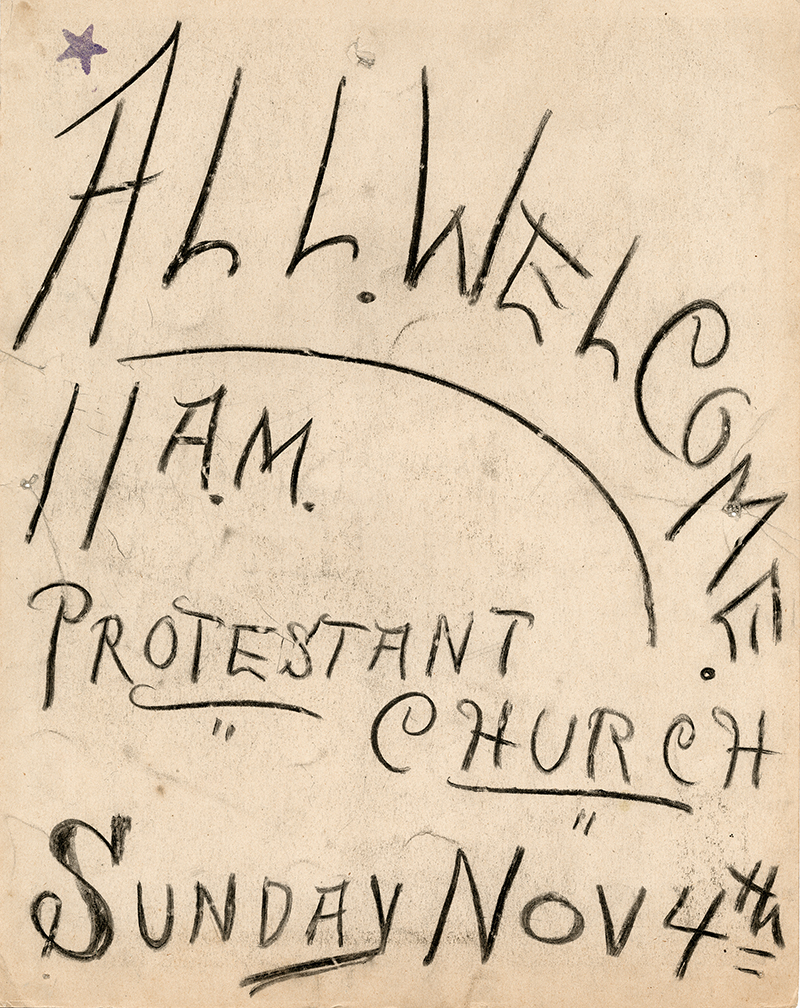"3 Jumps Ahead"
Starring Tom Mix

Click image to enlarge
| Download archival scan
An original 11x14-inch sepiatone lobby card shows Tom Mix and Alma Bennett astride Tom's "Wonder Horse" Tony in a scene from John Ford's "3 Jumps Ahead" (Fox Film Corp. 1923) — the movie in which Tom Mix jumped over Beale's Cut. Maybe.
The pinholes show that the lobby card was used for its intended purpose — in this instance to advertise a showing on Sunday, November 4, at the "Protestant Church," as written on the back. Unfortunately, we don't know what town or what state or necessarily what country the church was in. (This lobby card came to us in the year 2020 from a vendor in Canada.) We do know "3 Jumps Ahead" was released in the United States on March 25, 1923. November 4 was a Sunday in 1923 (and it wasn't a Sunday in 1924 or 1925), so this was probably a first-release showing, or as close to a first release as it got in a small town that had no dedicated movie theater. It wasn't unusual for movies to be shown in churches and schools and other public buildings in rural America. Newhall had to wait until 1941 for a dedicated movie house, when William S. Hart financed construction of the American Legion's American Theater (American Legion Post 507 today). Previously, films were shown in the 1925 Newhall School auditorium. Before that, Newhallians had to travel to the Cody Theatre in San Fernando if they wanted to see a movie that was made in their own town, such as "3 Jumps Ahead" with Tom Mix. Alma Bennett (1904-1958), birth name Alma Long, had just turned 15 when she got her start in movies in 1919. She co-starred in numerous comedies throughout the 1920s, but by the time she turned 25 the roles stopped coming; her last screen appearance came in 1931. Like an estimated 76 percent of all movies from the silent era, "3 Jumps Ahead" no longer exists. All that remains is the advertising ephemera, some of which, like this original lobby card, is exceedingly rare.
About "3 Jumps Ahead." Tom Mix "jumps" over Beale's Cut in Newhall in the 1923 John Ford 5-reeler, "3 Jumps Ahead," from Fox Film Corp. Mix, whose star rose as Bill Hart's waned, did a lot of filming in the Newhall area from about 1916 to the early 1920s, and ran one of several "Mixville" movie towns in downtown Newhall between San Fernando Road and Newhall Avenue, prior to his establishment of a permanent Mixville in the Silverlake area of Los Angeles. Mix claimed to have jumped Tony over Beale's Cut himself — not once but five or six times to get the shot. Mix biographer Robert S. Birchard, author of "King Cowboy: Tom Mix and the Movies" (1993) tells us he's certain Mix didn't do it. The film itself is lost, but Birchard, who owns seven frames of film showing the jump, insists the stunt was performed by Earl Simpson, a horse trainer and stuntman with a ranch in Searchlight, Nev. Others who've been credited with the stunt over the years are Richard Talmadge and Newhall's own Andy Jauregui. It's possible there is more than one answer. In addition to some crazy-looking cut-and-paste production stills that show the horse and rider drastically out of proportion to the Cut, there were three trailers for the film for different releases, Birchard says. They may have been shot at different times using different people. As for the loss of this and other early Tom Mix films, Birchard writes (Birchard 1993:133):
In 1937, 20th Century-Fox suffered a major vault fire at its East Coast storage facility, and the original negatives for virtually all of the Fox Film Corporation's silents and early talkies were lost. For years, it was thought that only two of Tom's eighty-five Fox pictures survived, "Sky High" (1922) and "Riders of the Purple Sage" (1925). However, in the late '60s, 20th Century-Fox embarked on a search for its early film heritage and a few more Mix titles turned up, including "The Untamed" (1920), "The Night Horsemen" (1921), "Trailin" and "Just Tony" (both 1922), "Soft Boiled" (1923), "The Rainbow Trail" and "Dick Turpin" (both 1925), "The Great K&A Train Robbery" (1926), and "The Last Trail" (1927). Another dozen or so titles turned up in Czechoslovakia, including "The Road Demon" (1921), "Teeth" (1924), "North of Hudson Bay" (1924), "The Best Bad Man" (1925), and "Oh, You Tony!" (1924). Unfortunately, the Czech versions generally survive in beat up exchange prints, with missing footage, and four-frame Czech flash titles, making them virtually incomprehensible. A print of "The Texan" (1920) is known to survive at the Danish Film Archive, and others may yet surface — although time is running out for any fragile nitrate prints that might rest in a forgotten vault, attic or garage as tantalizing fragments of "Hearts and Saddles" (1917) and "Fighting For Gold" (1919) attest.
About Tom Mix. Born in Mix Run, Penn., on Jan. 6, 1880, Tom Mix appeared in more than 300 films (counting "shorts") from 1909 to 1935. He occasionally filmed in Newhall from 1916 to the mid-1920s and set up one of his early "Mixville" Western movie towns between Spruce Street (now called Main Street) and Newhall Avenue. A part-time Newhall resident during that period, Mix lived across the street (probably on Walnut Street) from the Thibaudeau home, which was located at the southwest corner of Market Street and Newhall Avenue. In a televised interview, lifelong Newhall resident Gladys Thibaudeau Laney (1910-2014) said she observed Tom buying his sidekick "wonder horse" Tony on her family's property when she was a young girl. The timing works; Tom reportedly purchased Tony for $600 in 1917 from Pat Chrisman (1882-1953), a horse trainer and actor friend who co-starred in a number of Mix films (Birchard 1993:118). In the late Teens, Mix established his most famous "Mixville" on Glendale Boulevard in the Silver Lake section of Los Angeles. Prior to his movie career, Mix appeared in a series of Wild West shows where he was noticed by pioneering film producer Col. William N. Selig, who hired him to handle horses. He worked with Selig, writing, directing and acting, until 1917, when he signed with Fox to star in moving pictures alongside Tony. Mix reached the height of his popularity during the 1920s, assuming the mantle of King of the Cowboys from William S. Hart, who retired from filming in 1925. But Mix did not adapt well to "talkies," and his career waned in the 1930s. His popularity remained intact, however, as he took his show on the road on the Western performance circuit. It was on the road that he would perish, when his 1937 Cord sent him to an untimely demise on Oct. 12, 1940, south of Florence, Ariz. Adding insult to injury and death, most of the 85 films he made with Fox were lost in a 1937 fire at the company's East Coast storage facility. But Mix was remembered fondly through his radio show and comic books, which outlived him by more than a decade.
LW3693: 9600 dpi jpeg from original lobby card purchased 2020 by Leon Worden from a vendor in Calgary, Alberta, Canada.
|




